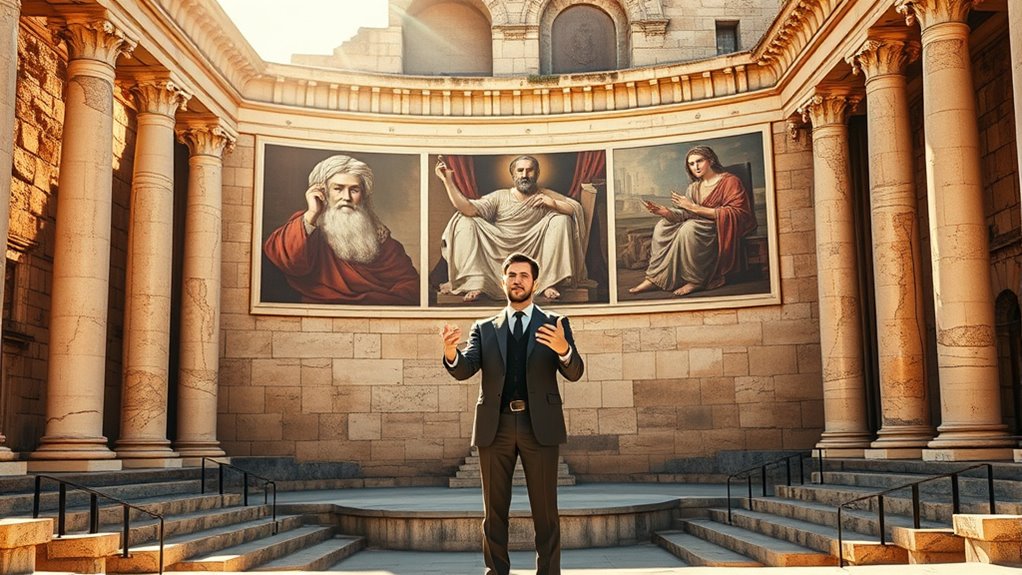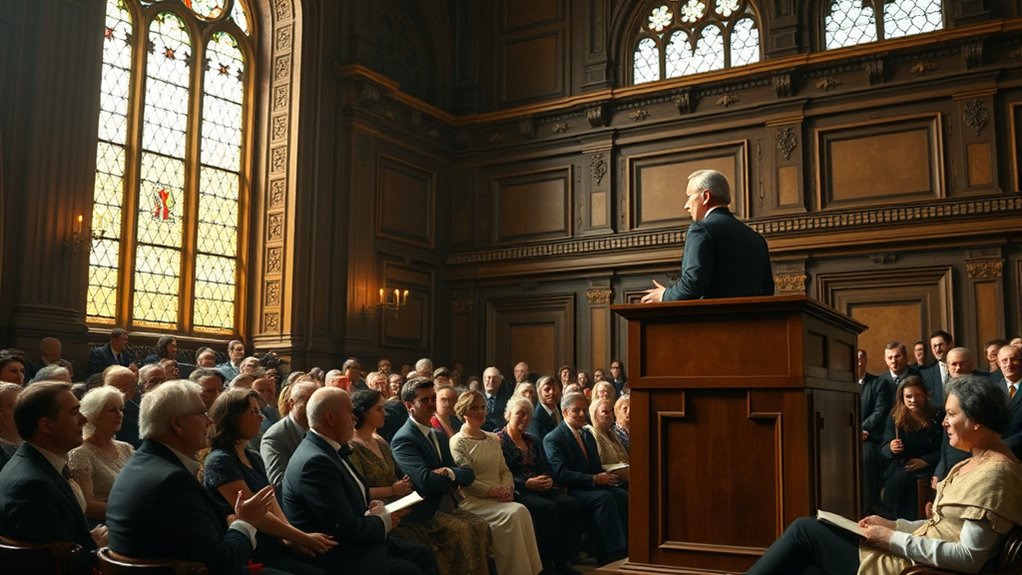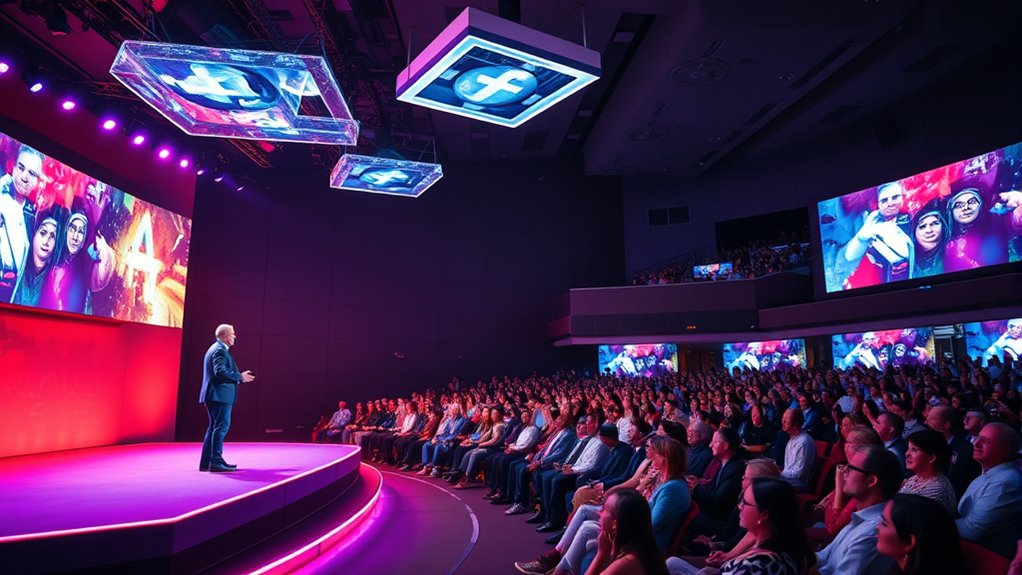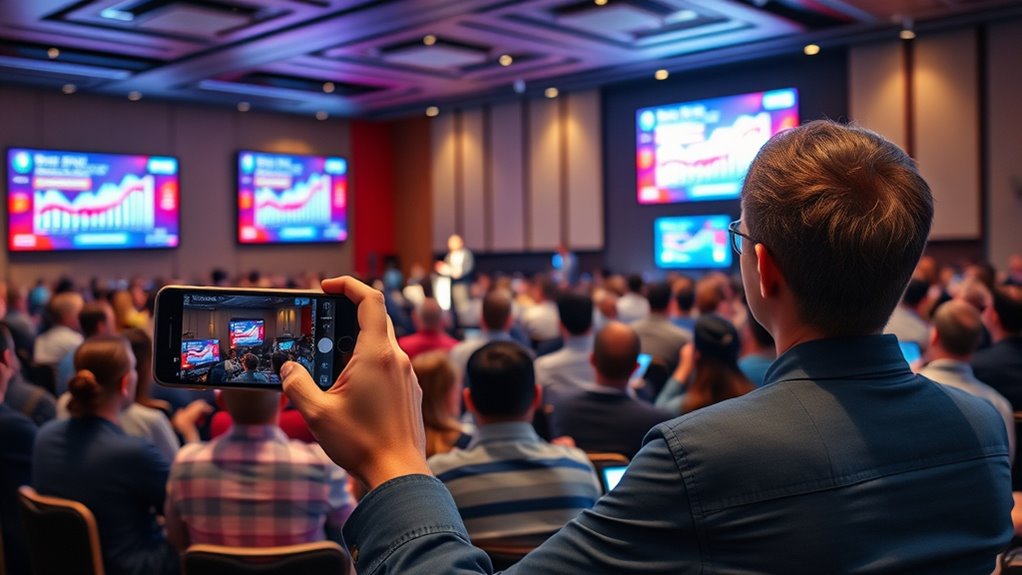The evolution of public speaking has shifted from ancient Greece’s rhetoric, focusing on persuasion and debate, to medieval religious discourse and Renaissance styles, emphasizing eloquence. During the Enlightenment, it fostered democratic discussion and critical thinking. Today, digital tools and platforms transform how you communicate, allowing for global reach, interactive engagement, and innovative influence strategies. If you keep exploring, you’ll discover how technology continues to reshape the way you connect and persuade audiences.
Key Takeaways
- Public speaking originated in Ancient Greece with rhetoric focused on persuasion, debate, and eloquence.
- During the Middle Ages and Renaissance, it shifted toward religious sermons and secular discourse, emphasizing style.
- The Enlightenment promoted rational debate and civic engagement, transforming public speaking into a tool for democracy.
- Technological advances introduced microphones, video conferencing, and digital tools, expanding reach and engagement.
- Today, public speaking has transitioned into digital formats, incorporating multimedia, interactive platforms, and global audiences.
Roots in Ancient Greece and the Birth of Rhetoric

Ancient Greece laid the essential foundations for public speaking by relying heavily on oral expression for communication. You see, it was a society where spoken words carried significant weight, shaping laws and influencing decisions. Figures like Socrates, Plato, and Aristotle pioneered methods that emphasized dialogue, persuasion, and critical thinking. This emphasis on oral tradition fostered a culture where spoken rhetoric was central to civic life.
In Athens, laws began to shift from oral tradition to written codes around 621 B.C., making legal knowledge accessible and encouraging public debate. The Greeks also developed rhetoric, meaning the art of effective speaking, which became pivotal in political gatherings and courts.
Aristotle defined rhetoric as discovering all available means of persuasion for a particular case. These innovations created a culture that valued debate, persuasion, and eloquence—cornerstones for modern public speaking. Rhetorical techniques were further refined to enhance the effectiveness of spoken arguments and persuasion.
Revival and Transformation During the Middle Ages and Renaissance

After the fall of the Roman Empire, the study and practice of rhetoric shifted markedly. Secular rhetoric declined as the Church took center stage, emphasizing sermons and religious discourse. You’d notice that preaching became the main form of public speaking, often borrowing persuasive techniques from classical rhetoric but adapting them to Christian teachings.
Monasteries and churches maintained rhetorical knowledge, but formal training was limited mainly to clergy. During the Renaissance, scholars rediscovered classical texts, sparking a revival of rhetoric focused on style and eloquence. Thinkers like Petrus Ramus challenged traditional views, blending logic with rhetoric. This period saw rhetoric become more secular, used in politics and law, while education expanded beyond ecclesiastical circles. The rise of humanism promoted individual expression, transforming public speaking into a more accessible and nuanced art form. Additionally, the Renaissance emphasized educational philosophies, which influenced how public speaking was taught and appreciated as a vital skill for personal and professional development. The renewed interest in classical rhetorical principles played a key role in shaping modern approaches to effective communication, as scholars emphasized the importance of persuasive techniques in both speech and writing. Furthermore, the integration of innovative teaching methods helped democratize rhetorical education, making it more inclusive and adaptable to diverse audiences. This era also saw the development of public speaking training, making rhetoric more systematic and accessible to a broader audience.
Enlightenment and the Rise of Democratic Discourse

How did the Enlightenment transform public speaking into an essential tool for democracy? It emphasized free expression and rational debate, making public speaking crucial for civic engagement. The period also saw the emergence of specialized venues such as salons and clubs that fostered public discourse, encouraging citizens to participate actively in societal debates. Educational reforms integrated public speaking into curricula, highlighting its role in fostering moral responsibility and political participation. The focus shifted from memorized speeches to reasoned arguments, encouraging citizens to think critically. This fostered a culture where open dialogue and debate became fundamental to governance. Additionally, the development of auditory processing techniques contributed to more effective communication and understanding among individuals. Furthermore, the rise of literacy among the general populace enabled a broader audience to engage with political ideas and participate meaningfully in discussions. As literacy improved, the importance of persuasive communication grew, helping to shape public opinion and policy. Enhanced communication skills were also cultivated through these educational initiatives, reinforcing the importance of articulate expression. As a result, public speaking became a powerful means to inform, persuade, and shape democratic societies—principles that still underpin modern civic life today.
Technological Innovations and the Expanding Reach of Public Speaking

Have technological innovations truly transformed public speaking by expanding its reach and accessibility? Absolutely. AI-driven feedback tools like Orai and Speeko help you improve your delivery with instant analytics. Innovative microphone systems make speeches adaptable to various environments, enhancing clarity. Devices such as MagniLink Vision boost accessibility for visually impaired audiences, ensuring inclusivity. Additionally, the use of color accuracy by projectors elevates the credibility and engagement of storytelling in multimedia presentations. Video conferencing platforms like Zoom allow you to connect with global audiences, breaking geographic barriers. AI speakers personalize engagement, delivering tailored content that resonates. These innovations mean you can practice with online resources, refine your skills through real-time feedback, and reach audiences worldwide. Moreover, technological accessibility features facilitate participation from diverse groups, broadening the scope of public speaking opportunities beyond traditional settings. The integration of delivery logistics into platforms also helps organizers ensure timely and quality presentations across different regions.
Modern Trends and the Impact of Digital Platforms

Digital platforms have revolutionized public speaking by making it more accessible and dynamic. You can now reach a global audience without geographical limits, broadening your impact.
Digital platforms expand your reach, making public speaking more accessible and impactful worldwide.
Hosting digital events cuts costs—no venue rentals, travel, or accommodations—making participation easier for everyone. Attending from anywhere saves time and resources, while interactive tools like live polls and Q&As boost engagement.
These platforms also promote diversity, allowing people from different backgrounds and locations to join in. Trends like bite-sized content on TikTok and Instagram keep messages concise and engaging, while data analytics help you tailor your presentations to specific audiences. Understanding the health benefits of various natural remedies can enhance your credibility and connect with health-conscious audiences. Additionally, choosing a preppy dog name can reflect your personality and add a touch of sophistication to your branding. Incorporating visual storytelling techniques can further elevate your presentations and captivate your audience.
Hybrid events combine in-person and virtual elements, creating richer experiences. Additionally, understanding store hours can help organizers plan events that maximize attendance and convenience. Overall, digital platforms transform how you communicate, offering new opportunities for connection, innovation, and influence.
Frequently Asked Questions
How Did Public Speaking Influence Ancient Greek Political Systems?
You see, in ancient Greek political systems, public speaking was essential. It allowed you to debate laws, persuade juries, and influence decisions in assemblies.
Skilled orators could sway public opinion, shape policies, and even determine legal outcomes. Rhetoric became a crucial tool for participation and power, turning words into a means to gain status, defend ideas, and advance democracy itself.
Your ability to speak well directly impacted political success and civic engagement.
What Role Did Women Play in the History of Public Speaking?
You might be surprised to learn that women have played a crucial role in public speaking throughout history. They’ve spoken out for social justice, equality, and human rights, often facing challenges and being overlooked.
Women like Sojourner Truth, Margaret Thatcher, and Oprah Winfrey have inspired change and shaped societal views. Their speeches continue to motivate future generations, highlighting the importance of women’s voices in public discourse.
How Did Public Speaking Evolve in Non-Western Cultures?
You see, in non-Western cultures, public speaking evolved through rich oral traditions, storytelling, and community-centered practices. Elders, spiritual leaders, and storytellers played key roles, emphasizing harmony and cultural values over persuasion.
As globalization and technology spread, traditional styles blended with Western methods, creating diverse communication approaches. You can appreciate how these unique practices reinforce cultural identity, adapt to modern platforms, and highlight the importance of collective expression over individual rhetoric.
What Are the Psychological Effects of Public Speaking on Speakers?
Public speaking can feel like walking a tightrope stretched tight with nerves, pulling at your confidence. You might experience waves of anxiety, trembling hands, or a racing heart that threaten to drown your voice. These feelings can cloud your mind, making recall difficult.
But with focus and preparation, you can tame the storm inside, transforming that turbulence into a powerful current that propels your message forward confidently and authentically.
How Do Cultural Differences Impact Modern Public Speaking Styles?
You see, cultural differences shape how you approach public speaking. For example, in some cultures, you might speak loudly and expressively, while others prefer subtlety and indirectness.
You need to adapt your style to match the audience’s expectations—using appropriate volume, language, and nonverbal cues. By understanding these cultural nuances, you can connect more effectively, avoid misunderstandings, and create a more engaging and respectful presentation.
Conclusion
As you reflect on the evolution of public speaking, you see how ancient Greece’s rhetoric contrasts with today’s digital platforms—both shaping how you communicate. While the roots are rooted in formal speeches, modern tools make your voice more accessible than ever. The journey from classical orators to viral videos shows that, whether in grand halls or online feeds, your ability to connect remains timeless. Embrace this history as you craft your next powerful message.










